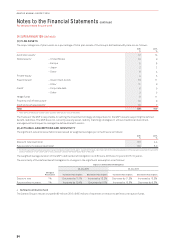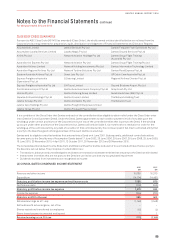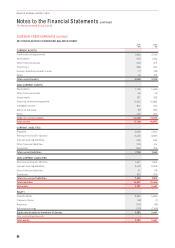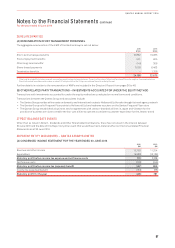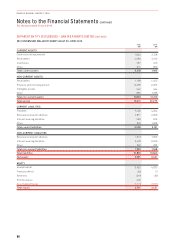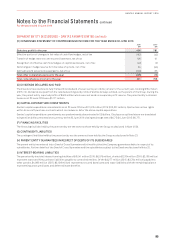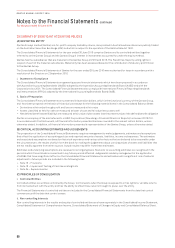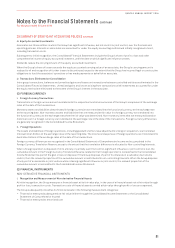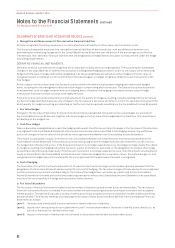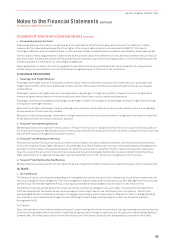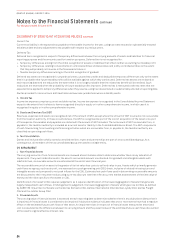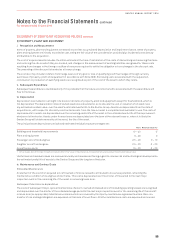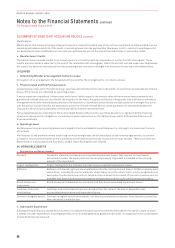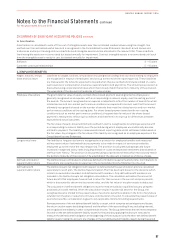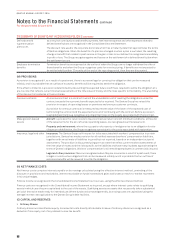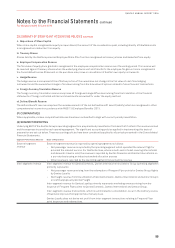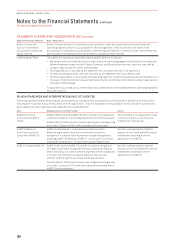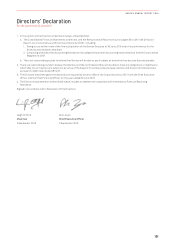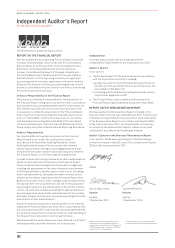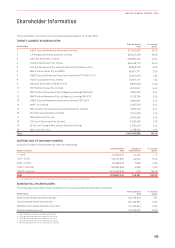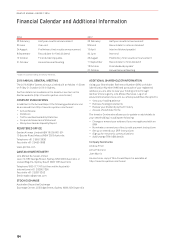Qantas 2016 Annual Report Download - page 96
Download and view the complete annual report
Please find page 96 of the 2016 Qantas annual report below. You can navigate through the pages in the report by either clicking on the pages listed below, or by using the keyword search tool below to find specific information within the annual report.
Notes to the Financial Statements continued
For the year ended 30 June 2016
29 SUMMARY OF SIGNIFICANT ACCOUNTING POLICIES CONTINUED
Current Tax
Current tax liability is the expected tax payable on the taxable income for the year, using tax rates enacted or substantially enacted
at balance date and any adjustment to tax payable with respect to previous years.
Deferred Tax
Deferred tax is recognised in respect of temporary differences between the carrying amounts of assets and liabilities for financial
reporting purposes and the amounts used for taxation purposes. Deferred tax is not recognised for:
–Temporary differences arising from the initial recognition of assets or liabilities that affect neither accounting nor taxable profit
–Temporary differences relating to investments in controlled entities and associates and jointly controlled entities to the extent
that they will probably not reverse in the foreseeable future or
–Taxable temporary differences arising on the initial recognition of goodwill
Deferred tax assets are recognised for unused tax losses, unused tax credits and deductible temporary differences only to the extent
that it is probable that future taxable profits will be available against which they can be used. Deferred tax assets are reviewed at
each reporting date and are reduced to the extent that it is no longer probable that the related tax benefit will be realised. Such
reductions are reversed when the probability of future taxable profits improves. Deferred tax is measured at the tax rates that are
expected to be applied to temporary differences when they reverse, using tax rates enacted or substantially enacted at reporting date.
Qantas provides for income tax in both Australia and overseas jurisdictions where a liability exists.
ii. Income Tax
Income tax expense comprises current and deferred tax. Income tax expense is recognised in the Consolidated Income Statement
except to the extent that it relates to items recognised directly in equity or in other comprehensive income, in which case it is
recognised in equity or in other comprehensive income.
iii. Goods and Services Tax (GST)
Revenues, expenses and assets are recognised net of the amount of GST, except where the amount of GST incurred is not recoverable
from the taxation authority. In these circumstances, the GST is recognised as part of the cost of acquisition of the asset or as part
of the expense. Receivables and payables are stated with the amount of GST included. The net amount of GST recoverable from, or
payable to, the taxation authority is included as a current asset or liability in the Consolidated Balance Sheet. The GST components
of cash flows arising from investing and financing activities which are recoverable from, or payable to, the taxation authority are
classified as operating cash flows.
iv. Tax Consolidation
Qantas and its Australian wholly owned controlled entities, trusts and partnerships are part of a tax consolidated group. As a
consequence, all members of the tax consolidated group are taxed as a single entity.
(H) IMPAIRMENT
i. Non-financial Assets
The carrying amounts of non-financial assets are reviewed at each balance date to determine whether there is any indication of
impairment. If any such indication exists, the asset’s recoverable amount is estimated. For goodwill and intangible assets with
indefinite lives, recoverable amounts are estimated at the end of each financial year.
The recoverable amount of an asset is the greater of its fair value less costs to sell and value in use. Assets which primarily generate
cash flows as a group, such as aircraft, are assessed on a cash generating unit (CGU) basis, inclusive of related infrastructure and
intangible assets and compared to net cash inflows for the CGU. Estimated net cash flows used in determining recoverable amounts
are discounted to their net present value using a pre-tax discount rate that reflects current market assessments of the time value of
money and the risks specific to the assets or CGU.
Identification of an asset’s CGU requires judgement, as it requires identification of the lowest aggregation of assets that generate
largely independent cash inflows. In Management’s judgement, the lowest aggregation of assets which give rise to CGUs as defined
by AASB 136:
Impairment of Assets
are the Qantas Domestic CGU, Qantas International CGU, Qantas Loyalty CGU, Qantas Freight
CGU and the Jetstar Group CGU.
ii. Financial Assets
The carrying value of financial assets is assessed at each reporting date to determine whether there is any objective evidence that it
is impaired. A financial asset is considered to be impaired if objective evidence indicates that one or more events have had a negative
effect on the estimated future cash flows of that asset. An impairment loss in respect of a financial asset measured at amortised
cost is calculated as the difference between its carrying amount and the present value of the estimated future cash flows discounted
at the asset’s original effective interest rate.
94
QANTAS ANNUAL REPORT 2016


